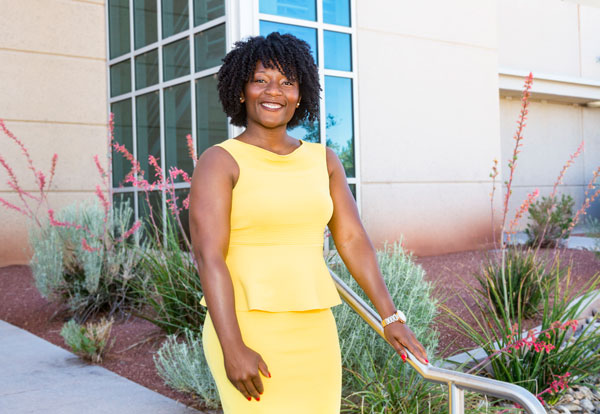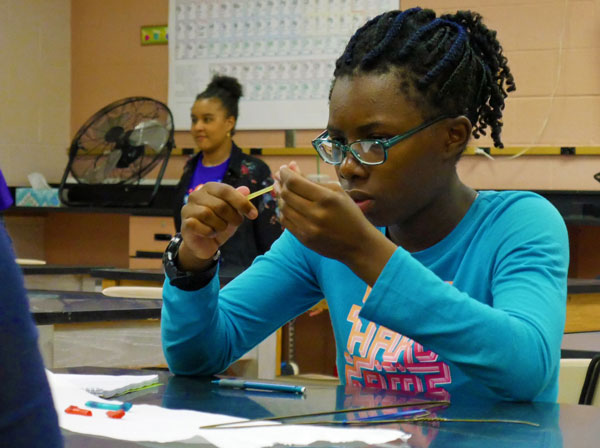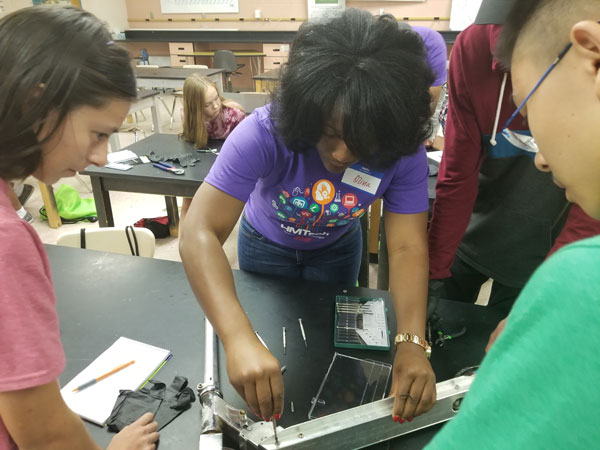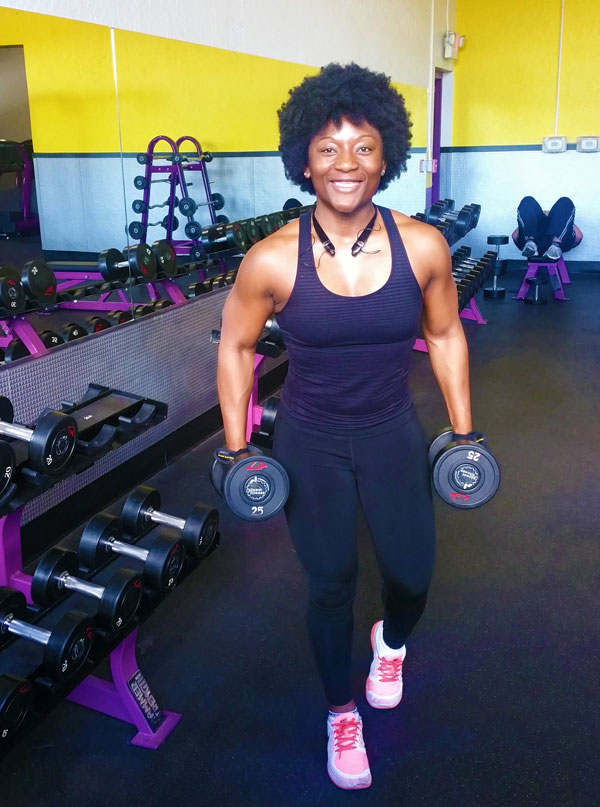Sandia materials scientist inspires students through STEM program

For 32 years, Sandia’s Black Leadership Committee has brought science, technology, engineering and math to more than 3,000 middle and high school students through the Hands-On, Minds-On Technologies program.
And for materials scientist Olivia Underwood, volunteering with HMTech is one way to make a difference in the community.
HMTech began as an after-school program to inspire African-American students to pursue STEM careers. Ten years later, it became a Sandia-sponsored summer program open to sixth- through 12th-grade students, primarily African-Americans.
More than 100 students participated in this year’s program, attending four six-hour Saturday sessions comprising two-hour blocks of instruction and hands-on learning. Students
chose classes based on their grade levels in such subjects as anatomy, physics, chemistry, fractals, video game programming, coding, renewable energy, robotics and website design with HTML and CSS. HMTech also offered personal development classes, including money management and career planning.
‘Exposure is key to success’
This is Olivia’s second year working with the program and her first year as an instructor. In her class — “What is Materials Science?” — students learn how to identify metals, ceramics, composites, polymers, semiconductors and other materials by disassembling items like a scooter, waffle maker, handheld mixer and electric stovetop.
The students also made replicas of the atomic structure of crystals using Styrofoam balls and toothpicks to better understand such concepts as atomic packing and stacking sequence. They made slime to observe the behavior of an amorphous solid.
Olivia taught mechanical properties by having the students use gummy worms, ice-pop sticks, paper clips, ceramic tiles and rubber bands to illustrate the elastic and plastic regions on the

stress-versus-strain curve and to characterize material failures as either ductile or brittle. The curve provides engineers and designers a graphical measure of the strength and elasticity of a material, and allows them to predict the behavior of materials used in a given application.

“It’s important to give back to the community, to show these kids that there are other people who look like them doing great things and they can do them too. Exposure is key to their success,” said Olivia, who began her career at Sandia three years ago as a materials mechanics postdoctoral research associate. She’s now a product realization team lead for an electronics group.
Faith, hard work and determination
Olivia grew up the youngest of seven children in Brent, Alabama. She remembers spending childhood hours taking things apart and analyzing them, and knew she wanted to be an engineer or a scientist. Her teachers encouraged her because she excelled in math and science. But her parents were her first teachers, instilling in her that with God, hard work and determination, she could do anything.
“What my parents wanted was for their children to be better than them,” said Olivia. “My parents only have a ninth-grade education, but they have Ph.D.s in life lessons. They made sure I was prepared for it.”
She learned from her siblings never to let her age, size or gender keep her from doing what she wanted, and refused to be told she couldn’t do something.
“Never allow others to place their limits on you,” she said.
Olivia earned her bachelor’s and master’s in metallurgical engineering from the University of Alabama in Tuscaloosa. She had several internships, including one at Los Alamos National Laboratory. She also worked as a failure analyst engineer with CGI Federal Defense at Red Stone Arsenal, home to the U.S. Army’s Aviation and Missile Research Development Center, and did research at the Center for Nanophase Materials Science at Oak Ridge National Laboratory.
At the University of Alabama in Huntsville, she felt challenged because initially she was the only African-American in her classes.
While the coursework was not difficult, she grew tired of fighting to prove herself, she said. She lost more than 10 pounds her first semester.
“I constantly had to remind myself that I was

not built to be broken and I was not going to leave without my Ph.D.,” she said. “As a black woman, it’s easy for someone to tell you what you can’t do, but no one is going to tell me what I can’t do.”
In 2015, she became the first African-American to earn a doctorate in materials science at UAH.
“It’s never easy to be the first one to do anything, but it’s always worth it when you are able to see others cross the finish line after you,” said Olivia. “I will continue to blaze those trails and remove those glass ceilings.”
Olivia knows African-Americans are underrepresented in math and science fields. To address the issue by helping others toward STEM careers, she established the Dr. Olivia D. Underwood Scholarship at her alma mater, Bibb County High School.
In addition to volunteering with HMTech, Olivia also serves as outreach co-chair of the Sandia Women’s Action Network, where she works to “engage members of Sandia’s workface and the local community to support activities for local youth in math, science and engineering,” and to promote “opportunities to improve visibility of women in science and act as a force for good in our local community.”
Olivia said she hopes her work with HMTech will show the students that they are capable of anything. “Change starts with me, and I do that when I lead by example. It’s important to give back and show our youth that they can do it too, because they are our future.”